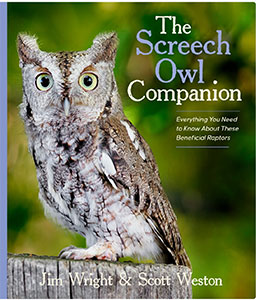Screeching for Justice: Help an Owl Out
Opinion Advocates for ideas and draws conclusions based on the author/producer’s interpretation of facts and data.

By Brian Kluepfel
What’s the size of a Coke can, lives in old knot holes and comes in three different colors? If you guessed screech owl, you’d be correct.
These pint-sized predators, existing in more than 25 genera across the Americas, from Manitoba to Maracaibo, were the subject of author Jim Wright’s book talk at Ossining’s Hudson Humanity for Books on Oct. 19 – fittingly, perhaps, shortly before our spookiest of holidays, Halloween.
Wright could be called a Megascops (the screech owl species name) maven. He’s spent more than two decades studying the birds, mostly from his northern New Jersey habitat, where he also writes a birding column for Bergen County’s The Record.
Having discovered, somewhat serendipitously, how deceptively simple it was to attract a screech owl to an artificial nest box in 2004, Wright’s fascination with the owl led him to co-author “The Screech Owl Companion: Everything You Need to Know About These Beneficial Raptors.” Noted photographer and co-author Scott Weston provided many of the outstanding images in this comprehensive tome.
The images were not easy to come by. Although screeches are abundant across their range – numbering perhaps 500,000 Eastern and 140,000 Western screech owls in the United States – their different coloring (“morphs” in biological terms) and shape make it relatively easy for them to blend in with their surroundings.
Even perched at the entrance of a tree hole, a grey, brown or red morph owl with its ear tufts extended to appear more stick-like, can be hard to spot. Wright’s tip: Look for them in sunny spots, early in the morning or late in the afternoon.
Wright’s book is comprehensive, describing the literature and lore of owls, listing the different species we may encounter in the Eastern U.S. and providing strategies for owl-friendly yards and inventive designs for nest boxes designed to keep the most insistent squirrel out.
Speaking of designing homes for these six-inch raptors, Wright also continues to fight against their most pernicious foe – pesticides and rodenticides. He reminded the audience that anything that ends in “cide” normally works its way up the food chain, from the rat, roach or mouse it was designed to eliminate, into the digestive tract of owls and other birds of prey. Screech owls eat a variety of prey, including worms, rats and even reptiles; thus, they are quite susceptible to malicious ingredients further down the line.
While car strikes continue to be a problem – owls get struck by vehicles while hunting for prey on well-traveled roads – these poisons continue to be an issue. His section “Beware of ‘Cide Effects” describes how these poisons affect not only birds, but bees and butterflies as well, a true cancer in the pollination chain. Mindful of how we might disturb birds while photographing them, the book offers tips on best photography practices as well.
Wright’s writing references some classic texts mentioning screech owls, from “Walden” to the “Harry Potter” series. He notes that while Henry David Thoreau and J.K. Rowling may have mentioned a generic screech owl, the species only exists in the New World, on this side of the Atlantic. The author also gives credit to his predecessor, Fred Gehlbach, who authored the definitive tome, the, “Eastern Screech Owl,” in 1994.
Another canard dismissed in the book involves the somewhat inaccurate name. Screech owls don’t truly screech; their calls resemble more of a horse’s whinny, or conversely, a short trill.
Wright’s co-author, Scott Weston, was crucial in developing comprehensive instructions in building and installing an owl box, as well as a camera to observe the feathered family. Wright reminds us that citizen science data collected by us average Joes helps to drive understanding (and sometimes legislation) of avian and other wildlife.
Armed with Wright’s book, we at Saw Mill River Audubon encourage you to go out and look for owls, and any other birds, for that matter. Our appreciation of our natural surroundings should only make us more diligent in protecting them. As we humans occupy more space, screech owls and other forest creatures live ever closer to us. As they acclimate to us, we should also do the same for them.
Hudson Valley Books for Humanity is a relative newcomer to our cultural scene here in Westchester. Please support them and other independent bookstores (maybe by buying Jim Wright’s awesome owl book). Keep human contact alive!
For more information on Jim Wright and his projects, visit www.screechowl.net.
Hudson Valley Books for Humanity’s virtual space is www.hvbooksforhumanity.com.
Brian Kluepfel is an author for the Lonely Planet travel series and will journey to South America this month to experience Bolivian birds, beers and beyond. He is a longstanding member of Saw Mill River Audubon and encourages you to check out the organization’s activities at www.sawmillriveraudubon.org. Also visit www.briankluepfel.com.

Examiner Media – Keeping you informed with professionally-reported local news, features, and sports coverage.
